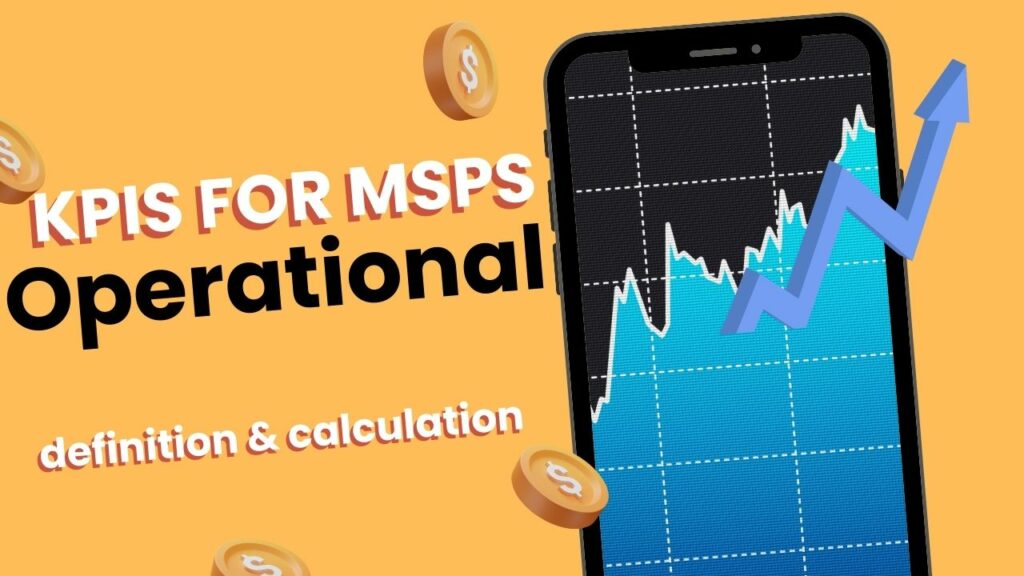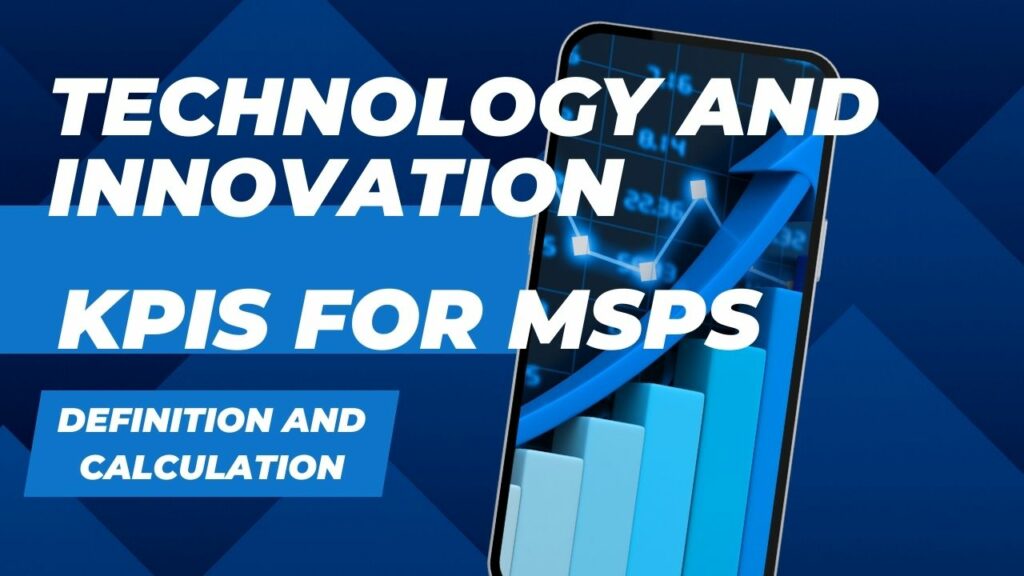For Managed Service Providers (MSPs) navigating the fast-evolving tech landscape, the mastery of MSP KPIs is not just beneficial—it’s crucial for success. Key Performance Indicators (KPIs) are far more than mere metrics; they shed light on the financial vitality, operational prowess, and client contentment levels within your business.
Through this article, we at Support Adventure, renowned for our exemplary MSP staffing services, underscore the critical role of MSP KPIs in guiding your business toward enduring prosperity.

In simple terms and with concrete examples, we will guide you through the benefits of measuring KPIs successfully for the best insight and results!
What are the KPIs for MSPs?
A Key Performance Indicator (KPI) is a measurable value that demonstrates how effectively a company is achieving key business objectives. These objectives can include financial, operational, customer-faced, and other benchmarks. They serve both as a guide and a formula for measurable improvement and maintenance of success.
For MSPs, KPIs are crucial because they provide a clear benchmark for guiding strategic decisions that enhance operational efficiency, financial performance, and customer satisfaction, ultimately driving the business towards growth and profitability.
With a focus on some vital KPIs (such as Monthly Recurring Revenue (MRR), Cost of Goods Sold (COGS), service desk efficiency, customer satisfaction scores, and more) you can transform how you measure and achieve success, ensuring your MSP not only meets but exceeds the benchmarks for financial and operational excellence.
In the world of Managed Service Providers (MSPs), the difference between thriving and barely surviving often boils down to the mastery of defining, measuring, and utilizing Key Performance Indicators (KPIs) for organization and growth. These aren’t just numbers on a dashboard; they’re the heartbeat of your MSP business, offering insights into financial health, operational efficiency, and customer satisfaction.
KPIs for MSPs Overview
What is the definition of key performance indicators, what is their importance for MSP business management, and which specific KPIs are most relevant to MSPs?
Definition of Key Performance Indicators (KPIs)
KPIs are like the dashboard in a car for MSPs. They provide critical information at a glance, helping you understand how well your MSP is performing against its strategic goals. Just as a speedometer helps you maintain the right speed, KPIs help you adjust your business strategies in real-time.
To quote a Forbes article, “A Key Performance Indicator (KPI) is a measurable target that indicates how individuals or businesses are performing in terms of meeting their goals.”
Importance of KPIs for MSP – Business Management
KPIs help identify areas of success and those needing improvement, guiding decisions from staffing to client management. Without KPIs, it’s like navigating a ship without a compass, risking resources and client satisfaction.
Overview of the KPIs relevant to MSPs
For MSPs, certain KPIs stand out in mapping the road to success.
According to an article from Connectwise, there are 20 KPIs for MSPs, separated into 3 groups:
- Profitability (Financial) KPIs
- Productivity (Operational) KPIs
- Client-Based KPIs
We will cover the crucial KPIs for a well-rounded approach. From financial to operational indicators such as service desk efficiency and customer satisfaction scores look into:
- Financial metrics like Monthly Recurring Revenue (MRR), Cost of Goods Sold (COGS)
- Sales and Marketing
- Strategic KPIs
- KPIs for Technology and Innovation
Each KPI serves as a piece of the puzzle, contributing to a comprehensive view of your MSP’s performance.
Financial KPIs for MSPs
Covering MRR – Monthly Recurring Revenue, COGS – Cost of Goods sold and Gross Margin, EBITDA -Earnings Before Interest, Taxes, Depreciation, and Amortization and how to calculate them.

Monthly Recurring Revenue (MRR): Definition and Importance
MRR represents the predictable revenue you can expect every month from subscriptions and services. By measuring MRR KPIs you can learn about how your client retention strategies are working, if your sales and marketing are hitting the right goals, and a general sense of your revenues’ health.
It’s like a farmer’s yield, where consistent harvests ensure sustenance and growth. Understanding MRR helps in forecasting and planning for scalability.
MRR Calculation Methods
Calculating MRR involves summing up the recurring charges billed to customers monthly. It’s akin to calculating your monthly income, ensuring you account for every source to get a clear picture of your financial health.
MRR Growth Rate (%) = ((Current MRR – Previous MRR) / Previous MRR) x 100
Cost of Goods Sold (COGS) and Gross Margin: Understanding COGS in MSP Context
In the MSP world, COGS includes the direct costs of delivering your services, such as staffing and software licenses. It’s like the ingredients cost for a restaurant. The lower the COGS, the higher your Gross Margin, signaling more room for investment and growth.
The Significance of Gross Margin
Gross Margin is a critical measure of your MSP’s efficiency in turning revenue into profit. A healthy Gross Margin is like a fertile field; it indicates that your business model is sound and that there’s potential for future growth and investment.
Gross Profit Margin (%) = ((Total Revenue – COGS) / Total Revenue) x 100
EBITDA (Earnings Before Interest, Taxes, Depreciation, and Amortization): Relevance to MSP Profitability
EBITDA offers a clear view of your MSP’s operational profitability, stripping away factors like tax and interest payments. It’s like assessing the health of a tree by its growth rings, providing insights into the core performance of your business.
EBITDA Calculation and Benchmarks
Calculating EBITDA involves subtracting expenses (excluding interest, taxes, depreciation, and amortization) from revenue. Benchmarks vary by industry, but a healthy EBITDA margin typically indicates a company’s operational efficiency and profitability potential.
EBITDA = Revenue – Expenses
You can read more about financial KPIs for MSPs in this MSP360 article.
Operational KPIs for MSPs
Measuring your MSPs’ service desk efficiency, utilization rates, and customer satisfaction.

Service Desk Efficiency: Average Resolution Time and First Contact Resolution Rate
For any MSP, the efficiency of its help desk is paramount. Metrics such as average resolution time and first contact resolution rate shine a light on how swiftly and effectively your remote MSP staff addresses client issues. Think of your MSP help desk as a pit crew in a race; the faster and more accurately they can get the car back on track, the better the outcomes.
These KPIs not only reflect the technical prowess of your MSP staffing services but also directly impact client satisfaction and retention.
Average Resolution Time (ART)
This KPI shows you how many tickets are solved in a specific time frame. The lower the score the better.
Average Resolution Time = Total Resolution Time for all tickets solved / No. tickets solved
First Contact Resolution Rate (FCR)
Good to measure efficiency and customer satisfaction but should not be used on its own.
FCR rate (%) = No. issues resolved on first contact / No. total no issues X 100
A good example on Geckoboard follows, “Let’s say that over a month, your customer service team has dealt with 175 questions and requests from your customers. Out of that, 112 of these issues were resolved at first contact.
The calculations for your First Contact Resolution rate would therefore look like this:
(112 / 175) x 100 = 64%” They also mention that “across industries, many claim that the benchmark for FCR is around 65-75%.”
Utilization Rates: Measuring Staff Productivity and Balancing Workloads
Utilization rate is the measure of how effectively an MSP staffing company utilizes its workforce. It shows how much time, in the whole shift, is used for doing the assigned tasks.
According to Timelyapp, “The basic formula is pretty simple: it’s the number of billable hours divided by the total number of available hours (x 100). So, if an employee billed for 32 hours from a 40-hour week, they would have a utilization rate of 80%.”
By tracking this KPI, MSPs can strike the perfect balance, ensuring their remote MSP staff is neither overburdened nor underutilized, optimizing the delivery of MSP services.
Customer Satisfaction Scores: Methods of Measurement and Importance in Client Retention
Customer satisfaction scores are the voice of your client base. Through surveys and feedback mechanisms, MSPs can gauge how happy clients are with the services received.
It’s the equivalent of asking diners for their meal feedback; positive responses mean they’re likely to dine with you again. High scores are often a direct result of effective MSP staff outsourcing strategies that align technical skills with client needs, fostering loyalty and reducing churn.
The surveys can be in various forms with the most common being scores from 1 to 5, or 1 to 10, satisfied/dissatisfied, good/bad…
CSAT Calculation
CSAT (%) = (No. positive responses / Total no. responses) * 100
If you had 300 positive responses out of 400 total responses your CSAT score would be 75%.
300 / 400 x 100 = 75%
Sales and Marketing KPIs for MSPs
Customer acquisition cost, customer lifetime value, and lead conversion rates.

Customer Acquisition Cost (CAC): Calculation and Industry Standards
CAC measures the total cost your MSP incurs to acquire a new customer, including marketing and sales efforts. It’s like calculating the cost of planting and nurturing a seed until it bears fruit.
Keeping CAC at an optimal level ensures that your MSP is not spending more to acquire a customer than they’re worth, thereby enhancing profitability.
Strategies for optimizing CAC include refining your marketing approach and ensuring your MSP staffing services are efficiently aligned with your sales processes.
Measuring CAC KPI
($) Total sales and marketing expenses / (#) new customers acquired = ($) CAC
Customer Lifetime Value (CLV or LTV): Predicting Revenue Streams and Strategies for Maximization
CLV is a forecast of the total value a customer will bring to your MSP over the entirety of their relationship with you. It’s akin to assessing the yield of a fruit tree over its lifetime.
Maximizing CLV involves nurturing customer relationships through excellent service, upselling, and cross-selling, leveraging the skills of your MSP outsourced staff to deliver value that keeps customers coming back.
Calculating CLV/LTV
Customer Lifetime Value (LTV) = Average Revenue Per Account (ARPU) / Customer Churn Rate
Lead Conversion Rates: Tracking and Enhancing Conversion Rates
This KPI measures the effectiveness of your MSP in turning potential leads into paying customers. It’s like measuring how many people who visit a store end up making a purchase. Enhancing conversion rates involves aligning your MSP staffing company’s sales efforts with market trends and ensuring that your sales team and marketing strategies are finely tuned to the needs and behaviors of your target audience.
Strategic KPIs for MSPs
Churn rate, Net promoter score, Annual recurring revenue
Churn Rate: Understanding and Ways of Minimizing Client Churn
The churn rate is the percentage of your customers who cancel or do not renew their services over a given period. It’s the equivalent of measuring how many diners decide not to return to a restaurant. Minimizing churn requires an in-depth understanding of client needs and providing unmatched services, often leveraging the cultural and technical compatibility of remote MSP staff to enhance client satisfaction.
Connectwise advises us: “To calculate, take the number of customers at the beginning of a certain time period (day, week, month, etc.). Then, subtract the final customer number at the end of that same time period. Divide this number by the number of customers at the beginning of that time period and you will have your customer churn rate.”
Alternative:
Churn Rate (%) = (Number of Clients Lost / Total Number of Clients at the Beginning of the Period) * 100
Net Promoter Score (NPS): Gauging Customer Loyalty and Satisfaction
NPS is a straightforward metric that asks customers how likely they are to recommend your services to others. It’s like asking friends if they’d recommend a movie they just watched.
A high NPS is a strong indicator of customer loyalty and satisfaction, often reflecting the quality of service delivered by your MSP staffing services and the effectiveness of your client management strategies.
Calculating NPS
(Total score of surveys / Total possible points) = Satisfaction rating.
Annual Recurring Revenue (ARR) Growth Rate: Assessing Long-term Growth and Stability
ARR growth rate is a key performance indicator for the long-term growth and stability of an MSP. It’s like measuring the annual growth rings of a tree to assess its health and growth over time.
A positive ARR growth rate indicates that your MSP is on the right path, with strategies for client acquisition, retention, and upselling — supported by efficient MSP staff outsourcing — contributing to sustainable business growth.
Measuring ARR
To calculate, sum all recurring payments for the current month.
Each of these KPIs serves as a crucial gauge for MSPs to measure and improve their performance across various aspects of their business, from operational efficiency and customer satisfaction to strategic growth and market positioning. By focusing on these metrics, MSPs can fine-tune their strategies, optimize their operations, and ultimately drive sustainable success.
KPIs for MSP Technology and Innovation
Measuring Infrastructure uptime and reliability – uptime percentage, service level agreements, benchmarking, and more.

Infrastructure Uptime and Reliability
For MSPs, ensuring that infrastructure remains operational without interruption is like keeping the lights on 24/7; it’s essential for client trust and satisfaction. High uptime percentages are akin to a reliable power grid, where outages are rare and swiftly addressed.
Infrastructure Uptime and Reliability as a Key Performance Indicator (KPI) for Managed Service
Providers (MSPs) refer to the measure of the consistency and availability of IT services and systems. This KPI is critical because it quantifies the percentage of time IT services (such as servers, network devices, and applications) are fully operational and available for use without any disruption. High uptime and reliability are crucial for maintaining client trust and satisfaction, as they directly impact the functionality and performance of the client’s business operations.
Uptime is often expressed as a percentage, representing the proportion of time systems are running smoothly versus the total time.
For example, an uptime of 99.9% (often referred to as “three nines”) means that systems are expected to be down for no more than about 8.76 hours over the course of a year.
How to Measure Infrastructure Uptime and Reliability
Implement Monitoring Tools: Utilize comprehensive monitoring solutions that can track the operational status of all critical infrastructure components. These tools should be capable of real-time monitoring and alerting to quickly identify when services are down or experiencing issues.
Calculate Uptime Percentage: This involves tracking the total available time versus the total operational time within a specific period. The formula is usually expressed as:
Uptime Percentage=(Total Operational Time – DowntimeTotal Available Time)×100
Uptime Percentage=( Total Available TimeTotal Operational Time – Downtime)×100
Service Level Agreements (SLAs): Refer to SLAs which often define the expected uptime and reliability standards. Measuring actual performance against these standards can provide a clear metric for assessing infrastructure reliability.
Automated Reporting: Use automated tools for generating reports that detail uptime, incidents of downtime, their duration, and the impact on services. This not only aids in measuring performance but also in identifying patterns or recurring issues that need addressing.
Root Cause Analysis (RCA): When downtime occurs, conducting an RCA helps in understanding the underlying causes. This is essential for developing strategies to prevent future occurrences and improve overall reliability.
Benchmarking: Compare uptime and reliability metrics against industry standards or benchmarks to evaluate how your MSP’s infrastructure performance stacks up against peers. This can provide insights into areas for improvement and competitive positioning.
Suggested Best Practices
Proactive Maintenance: Schedule regular maintenance and updates to prevent potential
downtime caused by software or hardware failures.
Redundancy and Failover Systems: Implement redundant systems and failover mechanisms to ensure that if one component fails, another can immediately take over, minimizing downtime.
Disaster Recovery Planning: Develop and regularly test disaster recovery plans to ensure quick restoration of services in the event of major incidents.
Innovation Adoption Rate
Staying competitive in the MSP field means adopting new technologies at a pace that matches or exceeds industry trends. It’s like riding the wave of innovation rather than being swept away by it. This KPI measures how quickly and effectively your MSP can integrate emerging technologies, ensuring services remain relevant and top-tier.
KPIs for Security and Compliance
The biggest threat to businesses today is data and security breaches. More and more businesses are looking to protect themselves against these threats. If you want your MSP to be the safe haven for your clients (present and potential) this is the metric you should focus on.
Time to Detect and Respond to Security Incidents
In the digital realm, speed is of the essence when dealing with security threats. This KPI is akin to a rapid response team’s efficiency, where quicker detection and action can mean the difference between a minor issue and a major breach.
Number of Security Incidents or Breaches
Keeping this number low is vital to maintaining client confidence and compliance with industry regulations. It’s like ensuring the fortress walls are impenetrable, with each incident a potential chink in the armor to be fortified.
Summary On The Topic of KPIs for MSPs
What we went over in the article.

Integrating KPI Monitoring into MSP Management
Incorporating a robust KPI monitoring system into your MSP management practices is akin to setting up a dashboard for a pilot. It provides a real-time overview of where adjustments are needed, ensuring the MSP remains on course towards its strategic goals.
Continuous Improvement and Adaptation
The path to MSP success is paved with the stones of continuous improvement and the ability to adapt to changing circumstances. It’s about evolving with the landscape, ensuring your MSP staffing company remains agile and responsive to both challenges and opportunities.
The Importance of KPIs in Steering MSP Business Towards Success
Ultimately, KPIs are the compass that guides MSPs through the complex landscape of managed services. They offer the insights needed to navigate toward success, ensuring that every decision is informed and every strategy is aligned with the overarching goals of growth and stability.
By focusing on these KPIs, MSPs can enhance their operational efficiency, bolster security measures, and embrace innovation, all while maintaining a keen eye on financial health and customer satisfaction. It’s through this comprehensive approach that MSPs can secure their position in the market and drive towards a prosperous future.



0 Comments